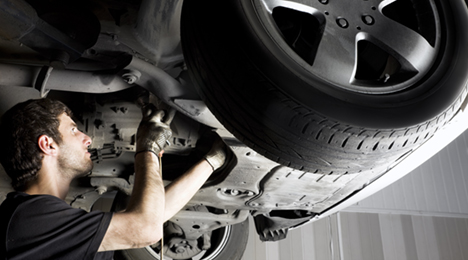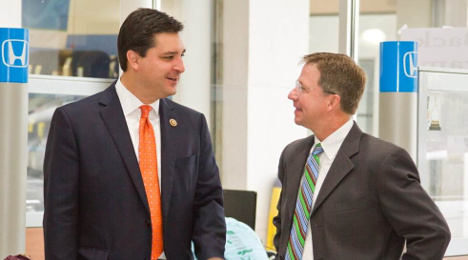The year-over-year double-digit climb in retail used-vehicle sales during the second quarter certainly got the attention of investment analysts who watch Lithia Motors’ results regularly.
What they wanted to know was whether Lithia could sustain this growth trajectory. President and chief executive officer Bryan DeBoer pointed to one factor as a reason why Lithia might be able to surpass the 27,716 used models dealer group stores rolled over the curb in Q2 by a healthy figure again next quarter and beyond.
“The used-car supply that we spoke to last quarter is starting to loosen, which means the units in operation that were sold and put into operation three years to five years ago is increasing,” DeBoer said when Lithia hosted its conference call to share its Q2 financial statement.
“We really believe that we have a great runway, because the supply of used vehicles is growing,” he continued. “We also believe that our future and our ability to take on market changes, the cyclicality or the implications of that or volatility are reduced if you can sell used vehicles.
“With the supply of vehicles out there, it’s been easier in many of our markets to be able to continue to grow profitability and continue to grow our used and/or service and parts space,” DeBoer added.
“And like we've talked about in the past, we believe that volume is a way to secure a stronger future,” he went on to say about used retail sales gains of 10 percent or more. “We believe that those type of levels will be able to persist because the supply is continuing to increase.”
Lithia is facing the same headwind in the used department that many other dealerships are — stop-sales from the Takata airbag situation and other recalls. DeBoer estimated that Lithia has about 1,100 units in inventory with a stop-sale tag.
"We have pretty good pent-up demand, and those are really high-demand certified vehicles that have customers waiting for them,” DeBoer said about those units waiting for parts so they can be made retail ready.
“There could be a surge in the second half so long as we see those parts coming,” he added.
Update on M&A activity
Lithia previously discussed how it has added a trio of stores to its portfolio so far this year with the most recent transaction bringing a GMC Buick franchise in Helena, Mont., into the fold. DeBoer hinted that more acquisition announcements could be coming.
“I think if we look back six months, what we were seeing was a lot of activity, but pricing was out of the range of most buyers,” DeBoer said. “But I think the difference that's occurring now is we’ve hit this point where pricing is more closely mirroring what we’re willing to pay. And I think we're going to continue to see that for the coming quarters.
“In our opinion, we think it’s going to be an extremely busy second half,” he continued. “And I think, most importantly, when we look at acquisitions our return expectations are really high. And if we recall what those are, we expect 20 percent after-tax return on our investments.
“That combined with the idea that we buy most of our stores in rural markets where real estate costs are fairly inexpensive, we really believe that when acquisitions come to be, Lithia is pretty darn close to a greenfield type of model because of that high return expectation, buying underperforming assets in rural markets at a low real estate cost,” DeBoer went on to say.
Energy-sector recovery
Earlier this year, TransUnion explained how economic conditions in energy-dependent states helped in part to push auto finance delinquencies higher in Q1. While the downturn in energy and oil prices still are having an impact, Lithia is noticing improvement as it tries to retail vehicles in these markets.
“Texas is starting to turn a little bit. They were still down a little bit in sales, and their profits were still obviously down. But their ability to start to learn again about used vehicle sales is starting to take hold,” DeBoer said. “We’re excited to see what’s happening in other energy states as well.
“Though Alaska was down a couple percentage points, their earnings were down, too, which is more indicative of what we’d like to see. If revenues go down, then earnings go down about the same, unlike where Texas didn’t have the ability to adjust with and replace new vehicle sales with used vehicle sales. They’re starting to grasp that,” he continued.
“On a positive note, Montana was up 18 percent in revenues, and they were up 22 percent in profit, which is more indicative of what we believe should occur when new vehicle sales begin to flatten, that you can replace those quickly with the other businesses of used vehicles and service and parts,” DeBoer went on to say.
Back in April, Manheim announced it was expanding its Retail Solutions operations to provide clients greater access to high-quality services that can produce retail-ready vehicles. During a discussion about its second-quarter results last week, Sonic Automotive described how Manheim is a “great business partner for us,” especially as the dealer group is looking to gain more momentum with its EchoPark stores — rooftops that only turn used metal.
Sonic’s EchoPark locations currently are all in the Denver area, which happens to be one of seven markets where Manheim Retail Solutions operations are in place or planned.
“Manheim is a great business partner for us. We love them. They're working their tails off. They're doing about half the inventory right now in the Denver market from a reconditioning perspective for us, which obviously lightens our load, overhead, that kind of thing. So slowly but surely they’re going to grow with us in the Carolinas and they’re going to grow with us in Texas,” Sonic president and chief executive officer Scott Smith said.
As the Sonic boss mentioned, Manheim revealed back in the spring that along with Manheim Denver and Manheim Chicago, the company was going to bring its Retail Solutions operations to:
—Manheim Orlando
—Manheim Houston
—Manheim St. Louis
—Manheim Detroit
—Manheim Darlington in South Carolina
Auto Remarketing joined the festivities in the Palmetto State as Manheim celebrated that portion of its $5 million investment. And happy clients such as Sonic evidently are showing that Manheim made a shrewd move.
“We’ve got plans and they’ve already made investments,” Smith said. “We’re going to continue to recondition cars as well. Right now, what we’re seeing is we’ve got such a demand, our business is growing cyclically, it’s taking both companies to really keep up for the number of stores that we have.
“And so hopefully as we move forward over the years here, Manheim will assume 100 percent of that and we’ll be out of the reconditioning and refurbishment business moving forward. But a little hybrid model between now and then as they get ramped up and we teach them some things and they teach us some things and we work together to accomplish that goal,” Smith went on to say.
When asked why Sonic would tap Manheim to handle so many responsibilities, Smith pointed out the financial impact to the group’s balance sheet, especially as Sonic tries to ramp up EchoPark’s performance that was one of the highlights of the second-quarter financial statement.
“We don’t have to build the facility to recondition cars. We don’t have to have the buying team. We don’t have to have all the technicians, all the staff, everything you have to have, so the economics will be significantly better,” Smith said.
More details about EchoPark
By the time Sonic executives faced questions from Wall Street observers, five EchoPark locations in Colorado were turning used vehicles. Sonic executive vice president of operations Jeff Dyke elaborated more about the group segment’s most recent performance.
“Thornton, which is our big hub, turned a profit for the quarter. That was our original store that opened up. The other two stores that opened up originally certainly are improving, Centennial is on its way there. Cash flow I think it’s close to being positive or positive,” Dyke said.
“Highlands Ranch, as we look at it, we probably under-built that store. It holds a 100 cars, and we really needed it to hold 150-plus cars. So that one is not improving as fast as we like it,” he continued.
“Then the other two stores that we just opened came out of the chute significantly faster than the stores that we originally opened, so we’re very excited about where we are,” Dyke went on to say. “Cash flow looks good. Profitability is certainly moving along for what we forecast if not better.
“And then our other two markets, Texas and the Carolinas, from a property perspective are coming on quickly, so nothing but positive things,” he added. “The feedback that we’re getting from our guests on EchoPark is nothing short of, ‘It’s just fantastic.’ If you read the feedback that we get, it’s unbelievable.”
While EchoPark locations have the capability to handle some service work for their customers, Dyke explained why Sonic isn’t shouting it from the top of the nearby Rocky Mountains, referencing again why Manheim is in play.
“We’re just not marketing it. We’re not out there running huge promotions and things like that to drive a bunch of business in because quite honestly we don’t have the available shop hours to handle it if they do come in,” Dyke said.
“We’ve reduced the number of head count on the EchoPark side in that marketplace, and Manheim’s increased their head count,” he continued. “We’re in the middle of kind of shifting as they take on more responsibility and they learn. They've got to produce a lot more cars than they’re producing today and they’re working on that.
“We’ve got a team that meets every week. We have a call. We’re just kind of moving through a transition as they learn and grow. So no, we’re not out there pushing yet. That would be a mistake on our part. We'd upset customers, and our whole EchoPark is about guest experience. We’ve got to make sure that we're prepared for that when we do start advertising and marketing,” Dyke went on to say.
Culture shift to online sales
An investment analyst questioned Sonic’s investment in brick-and-mortar facilities like EchoPark as platforms such as Carvana gain more steam in retailing vehicles through an entirely online process.
“Obviously, there’s no question that’s where the industry is going,” Dyke said. “The big question is how fast does it get there? If you still look at the volume leaders in all the markets, they are still brick-and-mortar stores, and so we are working on what we call Sonic Digital One Stop, and that is the ability for our guests to shop and purchase a vehicle online without ever having to come to our stores.
“As the industry moves that way, you need much less brick-and-mortar on both the new car side and the pre-owned side, but at the same time we're trying also to build our brand, and so that's why we've taken the opportunity to not build these big tens of millions of dollar palaces for pre-owned,” he continued.
Dyke indicated an EchoPark location costs Sonic about $7.5 million for the property and showroom. That value is meant to augment what the dealer group can do online with what it’s calling the Sonic Digital One Stop, which is projected to launch at the end of the year.
“We are working diligently with some of our vendor partners that we built One Sonic One Experience with and we look forward to introducing that to our customer base,” Dyke said.
Smith chimed in about online vehicles sales, too.
“It's important to note that nobody in the industry has a 100-percent paperless transaction that's going on right now. Every state has different franchise laws and different requirements on paper that has to be signed,” Smith said.
“To my knowledge we are as far ahead as anyone in the industry as far as delivering vehicles where the customer never, ever has to step foot at a dealership,” he continued. “We can do the entire transaction from the comfort of you sitting in your underwear, on your couch or out by the pool, you can buy car. We'll deliver it to your house with paperwork and you can sign it. Never have to see or speak to a single individual. We have that today.
“That's real. It’s not vaporware that happens. I don’t want to mislead you. It’s a very, very small percentage of our business. But if you think of these online retailers that you think that are out there just sucking up the industry, they're not,” Smith went on to say.
For each used vehicle it retails, Group 1 Automotive has been generating an average gross profit in the neighborhood of $1,500, and you can expect that to remain steady in the second half of the year.
In the company’s latest quarterly earnings call with investors, Group 1 said used-vehicle prices in car segments have been pinched, but with the speed at which the retailer has been able to turn those units, it hasn’t had made a significant impact on pre-owned gross profits.
“The biggest challenge in the used-car market right now is the pressure on the values of the cars. SUV and truck values are actually pretty firm … with the current low fuel prices, we still have a lot of customers trying to trade in cars for smaller SUVs and things like that,” Group 1 president and chief executive officer Earl Hesterberg said during last week’s call.
“And those are the challenges,” he said. “Just like most brands have an excess of new-vehicle car inventory, handling the car portion of the used-vehicle market is where the challenge is and where the most pressure is on values.”
But keep in mind, the dealership group is keeping its used inventory at a days’ supply of 34, said senior vice president and chief financial officer John Rickel.
“So, as long as we’re keeping abreast of what’s going on with those market conditions, we don’t have a lot of depreciation or residual value risk,” Rickel said,
“It’s just basically, you kind of buy them at the market and turn them pretty quickly and you avoid most of that,” he said. “We’ve been running $1,500 a unit and I think that’s a reasonable assumption for your second-half models.”
In the U.S., Group 1's gross profits per used retail sale were $1,496 in the second quarter, down from $1,502 in Q2 of 2015. For the first half of 2016, they came in at $1,558, up from $1,555 a year earlier.
Looking at consolidated results (including numbers for U.S. and international operations), gross profit per unit on used retail sales was $1,465 in Q2, even with year-ago figures. First-half numbers came in at $1,483, down from $1,501 in the first half of 2015.
Group 1 retailed 65,742 used units globally in the first half of 2016, up 7 percent year-over-year. In the U.S., it retailed 53,687 used units for a 3.3-percent gain.
Lithia Motors watched its retail used-vehicle sales figure overall and on a same-store basis climb by double digits year-over-year in the second quarter, which turned out to be the highest second quarter for adjusted net income in company history.
Lithia reported that it turned 12.3 percent more used vehicles during Q2 as all of the group's stores had 27,716 used models roll over the curb. On a same-store comparison, the year-over-year improvement came in at 10.2 percent.
The moving of more used metal helped Lithia overcome a 4.5-percent dip in used-vehicle gross profit as the per-unit figure softened to $2,425.
Also helping the company cause was a 4.9 percent increase in F&I gross profit per unit as the overall figure moved up to $1,271.
The used department helped to push Lithia to a 2-percent rise in Q2 unadjusted net income to $51.4 million, or $2.01 per diluted share.
For the first six months of 2016, Lithia highlighted its revenues increased 8.7 percent to $4.1 billion from $3.8 billion in the first six months of 2015 and unadjusted net income was $3.56 per diluted share, compared to $3.47 per diluted share. Adjusted net income per diluted share for the first six months of 2016 increased 8.0 percent to $3.52 from $3.26 for the first six months of 2015.
“Our stores delivered strong results in the quarter, growing all business lines,” Lithia president and chief executive officer Bryan DeBoer said. “Led by a 10.2-percent increase in used vehicle sales and a 7.4-percent increase in service, body and parts sales, our team is capitalizing on both a growing supply of used vehicles and units in operation sold over the past seven years that are now returning for service.
“We are capturing new-vehicle market share and increasing F&I per unit, which we believe are the key drivers to future organic growth, while maintaining adjusted SG&A as a percentage of gross profit below 67 percent,” DeBoer said.
Speaking of new vehicles, Lithia reported that when Q2 closed on June 30 its stores had retailed 36,059 new units, a 2.7-percent improvement year-over-year. Lithia’s new-vehicle margin improved by almost the same rate, ticking up by 2.3 percent to $2,021.
And Lithia continues to add more dealerships to its portfolio to turn both used and new metal. With the addition of a GMC Buick franchise in Helena, Mont. during the quarter, Lithia completed three acquisitions so far 2016.
“We anticipate a sustained new vehicle sales environment of 17 million units in the coming years. This provides Lithia several benefits including a predictable and profitable cadence of new car sales and incrementally higher service revenues as the vehicles sold over the past six years age and require maintenance,” DeBoer said.
“Additionally, the increasing supply of used vehicles will drive incremental revenue opportunities,” he continued. “Most importantly, a static SAAR level will spur further acquisitions as the aging dealer body seeks the optimal time to retire. These factors increase our confidence in establishing a new milestone of $9 in earnings per share, which we will strive to achieve through improvement in our existing locations and acquisition activity in both the Lithia and DCH platforms.
“We will continue our growth and believe the best use of capital is expanding our store base,” DeBoer went on to say.
Editor’s note: Watch for an upcoming report in Auto Remarketing Today highlighting more of Lithia’s used-vehicle operation.
The industry isn’t “over the cliff” at this point, but AutoNation chief executive officer Mike Jackson reiterated concerns he made earlier this year about too much incentivizing in the new-vehicle market, stressing that it’s an “unsustainable” model.
During the Q&A portion of Friday’s quarterly earnings call, Jackson responded to an analyst expressing concern about record new-car SAAR pulling used-car demand ahead, and the possible demand ramifications when used-car supply increases.
Jackson emphasized the importance of the warning he made earlier this year, saying in Friday’s call that “if the OEMs overdo it and push incentives too far, overproduce, push leasing too far, you are absolutely taking customers from the used-vehicle market and converting them into the new-vehicle market.”
“And at the same time, you’re increasing the supply of used vehicles coming back to the market on a faster turn,” he continued.
“Well, you can see that that is unsustainable. And there will be a day of reckoning. So, I’ve been very clear that there is a risk there. I don’t think we’ve gone over the cliff yet. I think there’s still plenty of time to manage this rationally and (be) disciplined,” Jackson said. “And don’t forget the retail market for used vehicles is 40 million units, so if you put it all together, we’re looking at a market that’s 55 to 60 million units between new and used. It’s very manageable.
“But can you screw it up? Yes, you can. And that’s why we’re speaking up.”
Jackson was quick to add that AutoNation’s public dealer group peers are mentioning putting more discipline towards cost and inventory.
The OEMs may not like it, he said, but the healthy route would be a “very profitable, sustainable, rational plateau period until we have very high interest rates or a major recession. And then volumes will fall.”
Penske Automotive Group has ramped up its supply of “young, used vehicles.”
During a conference call Thursday to discuss the company’s second-quarter earnings results, chief executive officer Roger Penske noted that in an effort to provide service customers on the premium luxury side with loaner cars, the auto group has grown its loaner car fleet to several thousand, which has increased supply of low mileage, late-model units.
“These are very good cars if you get them out with low mileage,” Penske said. “We’ve tried to accelerate that and try to have cars that are anywhere from 3,000 to 4,000 miles max and pull those out. And these are not cars we can’t sell; we just put them into loaner. These are good cars and we know they’ll come out and have good value.”
These cars then become a good way to move a customer that maybe doesn’t want to reach for a new car, Penske said.
“We’ve seen that quite rapid in growth from the standpoint of unit sales in the last quarter, and we expect that to be our offense to the end of the year.
“With the OEMs wanting us to take more of these vehicles, it gives us the opportunity to be able to put them into loaner, and I think that these lease returns also that we’ll get — for example, BMW we have 10,000 coming back just in 2016 — this is the fuel that runs the engine for us on the used-car side,” he said.
The auto group retailed 52,936 used units in the second quarter (U.S. and international combined), a 6.8-percent increase from the same period last year.
Gross profit per used vehicle came in at $1,697, down from $1,782 a year ago.
Used retail gross margin was 6.1 percent, down from 6.4 percent in the year-ago period.
More on Q2 performance
A conference call participant asked if perhaps Penske was driving incremental customers into the dealership as used supply improves.
“At some point, I might be cannibalizing a little bit on my new customer,” Penske responded. “It’s an opportunistic buy for the customer. The good news is, I take that customer, I put him into an almost-new vehicle. I’m going to get that parts and service, and if it’s a lease I’m going to get the opportunity to get that car back.”
Takata impact
Penske noted that about $57 million of the group's U.S inventory right now is on a stop-sale related to the ongoing Takara airbag recall situation. A conference call listener asked if replacement airbags are expected to arrive in large numbers anytime soon (i.e., third or fourth quarter) to give a bump in used-vehicle sales.
“We have to focus on customer cars and then we would focus on cars in inventory. … The good news is, some of the vehicles we have on stop-sale are very good used cars, and I think that’s had some downward impact in our used-car business, at least in BMW here at least in the last 60 days, but I see that flowing out,” Penske said.
“The only risk that I think we have is if everyone decides to wholesale these cars into the market instead of retailing them, there may be some value deterioration,” he said.
He pointed out that company is looking at a 0.85 to 1 used-to-new ratio
“Look at BMW: I’m over 1-to-1 used-to-new," Penske said. “So we see that as an opportunity not as a risk.”
Overall, the company recorded a record quarter with retail unit sales, revenue, income from continuing operations and earnings per share among the milestones.
Asbury Automotive Group is being affected by stop-sales related to the ongoing Takata airbag recall to the point that some company stores are running out of available space to park them.
The company on Tuesday reported a 4 percent dip in used vehicle retail revenue during the second quarter, with unit sales down 5 percent on a same-store basis.
However, “With better used vehicle management, we were able to improve our gross profit per unit by $114 to $1,769, our highest level in a year,” David Hult, executive vice president and chief operating officer, said during a conference call in which company executives discussed quarterly earnings.
According to Hult, stop-sales tied up 10 percent or roughly $16 million of Asbury’s inventory in the second quarter. That’s up from $14 million in the first quarter.
About a third of the automotive group’s more than 80 stores are affected by stop-sales. At some stores, as much as 40 percent of inventory is impacted.
“We’ve been told by our partners that they’re going to take care of the customers first, inventory second,” Hult said. “We are being compensated.”
As far as how the OEMs are making up for vehicle depreciation, that varies, he said.
“Every OEM is different. On some of them, there will be no economic impact. On others, there will be probably some loss that we’re going to suffer by the time we get these lots cleared.”
How fast the lots get cleared, of course, depends on how fast the replacement airbags arrive. Recent estimates indicate that only a fraction of the 70 million or so recalled vehicles in the U.S. have been repaired.
“They’re (the airbags) coming in on a very light flow, but not what we expected by this point. And what we’ve heard most recently is we shouldn’t expect to see them in any kind of volume until later in the third quarter, potentially early fourth quarter,” Hult said.
Craig Monaghan, president and chief executive officer, chimed in on a scenario in which “40 percent of your inventory is on stop-sale, and we’re running out of space.
“In some cases, we’re looking for nearby lots to park these vehicles,” he said. “It has become very disruptive. But they are vehicles that, when we get the airbags, that we think are going to be very marketable. So we are holding on to them for the most part, and we’re just going to ride this thing out.”
While Sonic Automotive’s EchoPark operations continued to gain steam during the second quarter, the dealer group’s overall used-vehicle performance during the second quarter softened a bit when compared to a year ago.
Sonic highlighted on Tuesday that its EchoPark stores — rooftops that only turn used metal — posted a 28.9-percent sales gain in Q2, retailing 1,136 vehicles — a figure up by 255 units. And just before the quarter closed on June 30, Sonic rolled out two more EchoPark locations in the Denver market.
“We are also very pleased with the continued progress of EchoPark as we opened two new stores in the Denver market,” Sonic executive vice president of operations Jeff Dyke said. “Our property acquisitions in the Carolinas and Texas remain active.
“We are beginning to see store-level profitability as our EchoPark brand grows in Denver, and thus fueling our excitement about EchoPark and its long-term prospects in an industry that is ripe for our guest experience model,” Dyke continued.
“The guest feedback at EchoPark is remarkable, further supporting our strategic entry into this part of the pre-owned market. We have listened to our guests' needs and are delivering on those expectations,” he went on to say.
EchoPark certainly was the shining part of Sonic’s used-vehicle performance in Q2. The group watched its overall used sales dip by 3.3 percent to come in at 29,287 units. On a same-store basis, Sonic’s used sales ticked lower, too, only by 1.8 percent.
At the same time, Sonic’s Q2 gross margin percentage dropped to 5.9 percent, down from 6.2 percent a year earlier. The group’s used gross came in at $1.262 per used unit retailed, off from $1,343 in the year-ago quarter.
However, Sonic didn’t pull the wholesale lever on as many units during the second quarter. The group wholesaled 7,212 vehicles, down from the 8,010 units that went down the lanes or to wholesalers a year earlier.
Despite some turbulence in the used department, Sonic generated net income from continuing operations for the second quarter of 2016 of $23.0 million, or $0.50 per diluted share. Included in these amounts are a pre-tax loss of $3.4 million, or $0.04 per diluted share, related to EchoPark operations.
Net income from continuing operations and related diluted earnings per share for the second quarter of last year were $15.1 million and $0.30 per share, respectively. On an adjusted basis, net income from continuing operations for the second quarter of 2015 was $23.4 million, or $0.46 per diluted share. Included in these adjusted amounts is a pre-tax loss of $4.1 million, or $0.05 per diluted share, related to EchoPark operations.
Helping to lift Sonic’s top-line Q2 numbers were a 3.0-percent rise in same-store fixed operations revenues as well as a 2.9-percent gain in same store finance and insurance revenues and gross profit.
On the new-car side, Sonic’s sales softened by a similar rate as its used department. Sonic retailed 33,782 new models, down 3.4 percent year-over-year. The gross profit percentage on those new models stayed flat at 5.1 percent as Sonic posted $1,949 in gross when a new model rolled over the curb.
“The industry was solid again this quarter and our performance reflected that,” Dyke said. “Our Sonic Automotive franchise store business continues to be supported by our team’s ability to execute our playbook processes as we work to perfect the One Sonic-One Experience culture in our stores.
“Our guests' responses to our new process, technology and culture have been excellent as reflected in our customer satisfaction scores and the reviews we receive via Google, Yelp, etc.,” he continued. “While we saw a decline in the new car retail SAAR in the quarter, new car margins have stabilized and heavy new car inventories from the first quarter are coming back in line with historical levels.
“We have worked with our manufacturer partners to develop action plans to address recall and stop-sale issues across several brands and are executing those plans,” Dyke went on to say. “We are pleased that we will be opening several new add points this year including Mercedes Benz in McKinney, Texas (outside of Dallas), Audi in Pensacola, Fla., and Nissan in Cleveland, Tenn. (outside of Chattanooga).
“These additional points reflect the strength of our organization and relationship with our manufacturer partners. We look forward to announcing several more add points in the coming quarters,” he added.
Contrary to what’s been plaguing many dealers, Asbury Automotive Group enjoyed a rise in used-vehicle gross margin during the second quarter despite a retail environment that president and chief executive officer Craig Monaghan described as “choppy."
Group management reported during a conference call to discuss Q2 results on Tuesday that its used-vehicle gross margin moved from 7.7 percent a year ago to 8.3 percent in the quarter that wrapped up on June 30.
Asbury, which operates 82 dealerships and three stand-alone used-vehicle stores, reported net income for the second quarter of $36.7 million, compared to $41.1 million in the same quarter last year.
Total revenue for the second quarter was $1.6 billion, down 4 percent year over year (attributable mostly to strategic divestitures during the second half of 2015, according to senior vice president and chief financial officer Keith Style).
Total revenue on a same-store basis was down 1 percent year over year.
Asbury logged 19,612 used vehicle sales in the second quarter, down from more than 21,000 in the same quarter last year, and has generated more than $831 million in used retail revenues year to date.
Retail revenue on the used side was $418.3 million, down 7 percent year over year, while used gross profit fell by 1 percent.
Used-vehicle unit sales were down 5 percent, attributable mostly challenges associated with stop sales. That being said, with better used-vehicle management, gross profit per unit increased to $1,769, “our highest level in over a year,” said David Hult, executive vice president and chief operating officer.
And with improved wholesale performance, total gross profit was up 3 percent.
Average price per used unit was $21,329, up slightly from the same period a year ago, while average gross profit per used unit was up slightly as well.
On a same-store basis, Asbury saw used-retail revenue of $411.8 million for the quarter, down from $429.3 million in the same period last year. Used retail gross profit came in at 34.1, up 0.5 percent year over year. Also on a same-store basis, used retail gross margin was 8.3 percent, up from 7.8 percent in the same period a year ago.
Asbury opened its third Q Auto store, in Tampa, Fla., during Q2, with a fourth slated to open in the same market next month.
Reiterating a “choppy” sales theme thus far in 2016, Monaghan nonetheless said Asbury’s teams have responded well to the challenge.
But how, if at all, has this altered expectations since January?
“I think we sit here today in a market where we have a good week and bad week, a good month and a soft month,” Monaghan said. “Broadly speaking, I don’t think things feel a lot different. There’s certainly plenty of uncertainty. … We need to make sure out stores are right-sized and staffed appropriately. … We continue to look for ways where we can drive incremental productivity, and capital allocation is key.
“I think one thing that we might think about that’s maybe just a little different today than it was in January is that we think this type of environment creates a lot of opportunity. We think it makes sense for us to stay flexible.”
Editor’s note: Stay tuned for a look at how stop-sales are impacting Asbury Automotive Group’s used business.
Like their contemporaries at the National Automobile Dealers Association, leaders from the American International Automobile Dealers Association are urging dealer principals to reach out to members of Congress as they adjourn for their summer recess.
AIADA insisted the best way to forge a meaningful relationship with elected officials is through its Dealer Visit Program.
“We rely on the involvement of our dealers to make an impact on legislators and policymakers,” AIADA said. “There is no better time to host your member of Congress at your dealership.”
The AIADA Dealer Visit Program can allow members of Congress to see first-hand the challenges and rewards of running a successful dealership.
The experience generally consists of a one-hour visit where the lawmaker will come to the dealership, conduct a mini town hall forum with managers and store employees, and tour the facility. By opening the dialogue between dealers and lawmakers, AIADA emphasized both parties can learn about each other’s businesses.
“It is an opportunity to jump start a vital one-on-one relationship between dealers and elected officials and provides the members with a look into how the decisions made in Washington affect the daily lives of dealers and their employees,” the association said.
Last summer, Stevenson Honda in Wilmington, N.C., hosted Rep. David Rouzer, a North Carolina Republican.
“The opportunity was invaluable,” Stevenson Honda general manager Patrick Koballa said about the event that included “a thoughtful discussion about automotive industry issues.”
Koballa added, “Congressman Rouzer got a chance to see the day-to-day operations of our business and how his decisions in Washington impact our community, and Stevenson Honda employees got a chance to talk one-on-one with a key decision-maker in Washington.”
AIADA said the best part of the Dealer Visit Program is the association said it will handle all the details — from scheduling and talking points to media advisories and event logistics.
AIADA acknowledged that August schedules are quickly filling up and now is the time to start planning for your visit. Dealers can contact Sarah Martinez, manager of grassroots and government relations, at Martinezs@AIADA.org or (703) 519-7800 to schedule a dealership visit.












